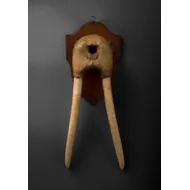An Exceptional Large Specimen of a Pacific Arctic Walrus Skull Complete with Tusks ‘Odobenus Rosmarus’
An Exceptional Large Specimen of a Pacific Arctic Walrus Skull Complete with Tusks ‘Odobenus Rosmarus’
Mounted on an Oak Shield (old paper collection number ‘121’)
Old lot number to reverse: ‘983’
Arctic
Circa 1900
SIZE: walrus: 70cm long - 27½ ins long
shield and walrus: 76cm high - 29⁷⁄₈ ins high
Mounted on an Oak Shield (old paper collection number ‘121’)
Old lot number to reverse: ‘983’
Arctic
Circa 1900
SIZE: walrus: 70cm long - 27½ ins long
shield and walrus: 76cm high - 29⁷⁄₈ ins high
An Exceptional Large Specimen of a Pacific Arctic Walrus Skull Complete with Tusks ‘Odobenus Rosmarus’
Mounted on an Oak Shield (old paper collection number ‘121’)
Old lot number to reverse: ‘983’
Arctic
Circa 1900
SIZE: walrus: 70cm long - 27½ ins long
shield and walrus: 76cm high - 29⁷⁄₈ ins high
Mounted on an Oak Shield (old paper collection number ‘121’)
Old lot number to reverse: ‘983’
Arctic
Circa 1900
SIZE: walrus: 70cm long - 27½ ins long
shield and walrus: 76cm high - 29⁷⁄₈ ins high
The largest, heaviest pinniped, the Pacific male walrus is a huge animal. Record specimens can measure more than 13 feet long and weigh up to 3500lbs. Ranging the Polar Seas at the top of the world they are the constant inhabitants of the ice floes, following them south in the Winter and north in the Summer.
An agile and expert swimmer in spite of its great bulk it often cruises leisurely with slow alternate strokes of its hind flippers. The walrus uses its tusks to hoist itself upon the ice, in defence, to prod its neighbours and to gather clams and other shellfish. The walrus, when hungry, will dive to the sea bottom, stand on its head and move slowly backward using its tusks and stiff cheek bristles to loosen shellfish from the sand. The literal meaning of their scientific name ‘Odobenidae’ is ‘those that walk with their teeth’.
In about 870 AD a Viking Norseman named ‘Othere’ recorded that he had made a voyage beyond Norway to hunt for ‘Hvalross’, ‘horse whales’ which he declared ‘have in their teeth bones of great price and excellence’. Norse colonists living in Southwest Greenland historically paid a tribute in walrus tusks to the Papal Legate in Rome where they were regarded as a form of currency. For the next three centuries the Norwegians hunted the walrus among the islands of the far North taking as many as one thousand or more annually. Today, under protection, the walrus again number several thousand in the Bering Sea area.
An agile and expert swimmer in spite of its great bulk it often cruises leisurely with slow alternate strokes of its hind flippers. The walrus uses its tusks to hoist itself upon the ice, in defence, to prod its neighbours and to gather clams and other shellfish. The walrus, when hungry, will dive to the sea bottom, stand on its head and move slowly backward using its tusks and stiff cheek bristles to loosen shellfish from the sand. The literal meaning of their scientific name ‘Odobenidae’ is ‘those that walk with their teeth’.
In about 870 AD a Viking Norseman named ‘Othere’ recorded that he had made a voyage beyond Norway to hunt for ‘Hvalross’, ‘horse whales’ which he declared ‘have in their teeth bones of great price and excellence’. Norse colonists living in Southwest Greenland historically paid a tribute in walrus tusks to the Papal Legate in Rome where they were regarded as a form of currency. For the next three centuries the Norwegians hunted the walrus among the islands of the far North taking as many as one thousand or more annually. Today, under protection, the walrus again number several thousand in the Bering Sea area.
Ex Private collection Edric Van Vredenburgh, published no. 107, vol 1, EVV collection catalogue 2014
‘No. 121’, from Knockdown House collection, Argyll, lot 983, Phillips, Scotland, July 1990
Ex Private collection Mr James Lamont
SEE: For an example on a shield see Finch and Co item no. 4, catalogue number 4, 2004 and also item no. 18, catalogue number 26, Summer 2016
‘No. 121’, from Knockdown House collection, Argyll, lot 983, Phillips, Scotland, July 1990
Ex Private collection Mr James Lamont
SEE: For an example on a shield see Finch and Co item no. 4, catalogue number 4, 2004 and also item no. 18, catalogue number 26, Summer 2016
An Exceptional Large Specimen of a Pacific Arctic Walrus Skull Complete with Tusks ‘Odobenus Rosmarus’

SOLD
YOU MAY ALSO LIKE

